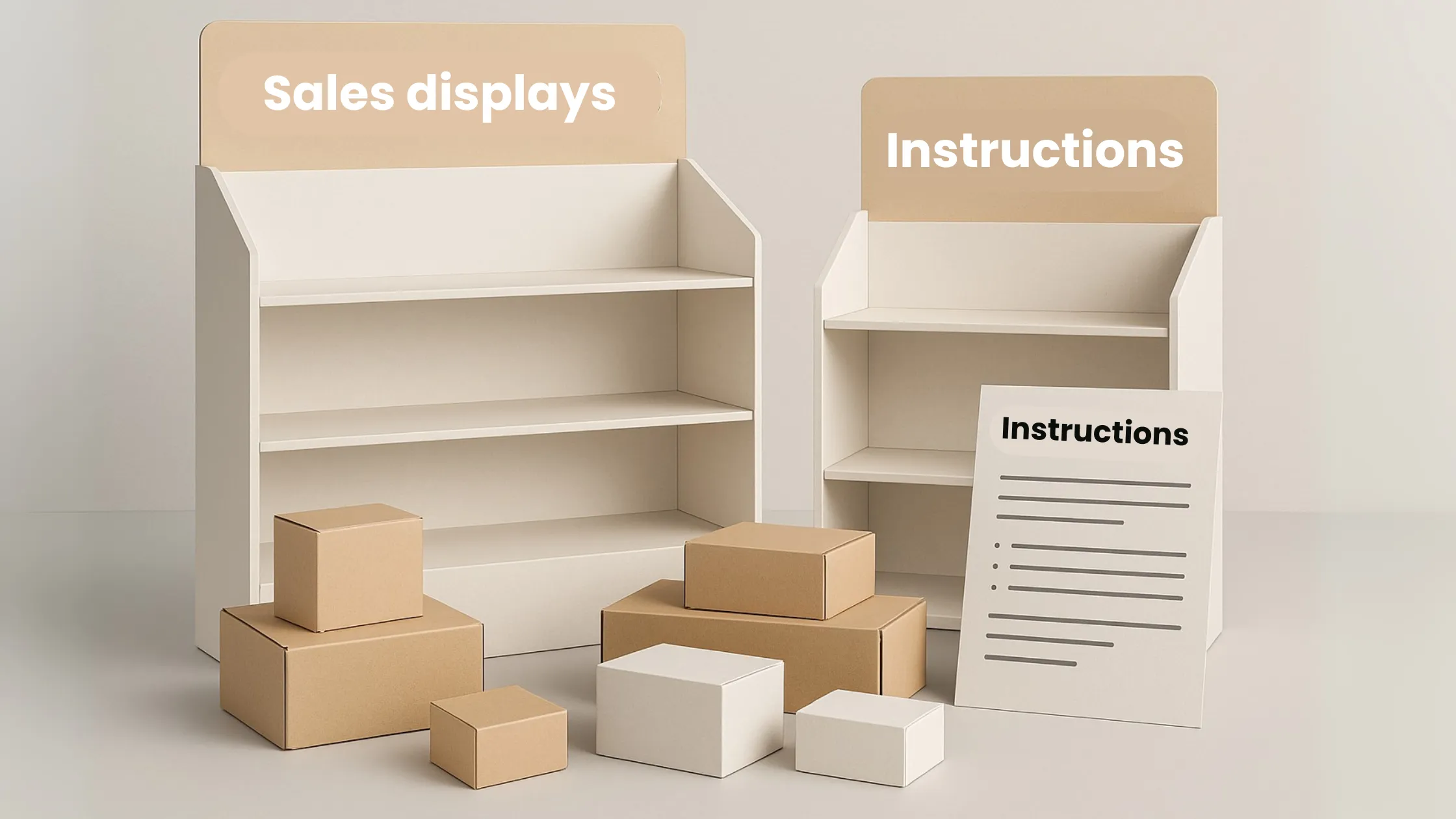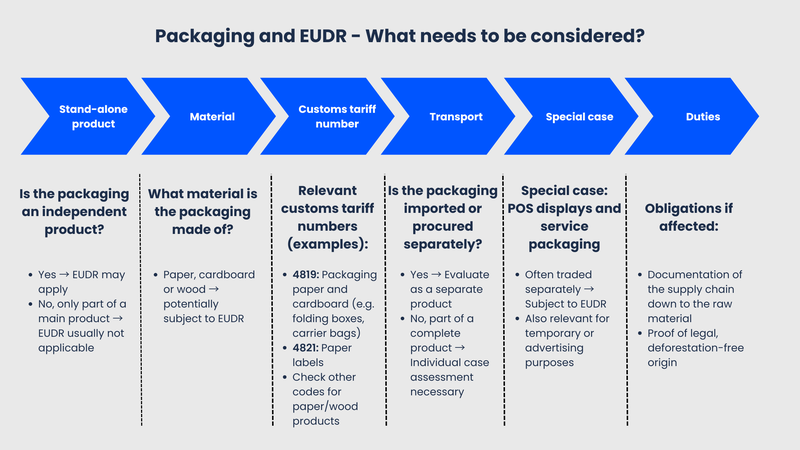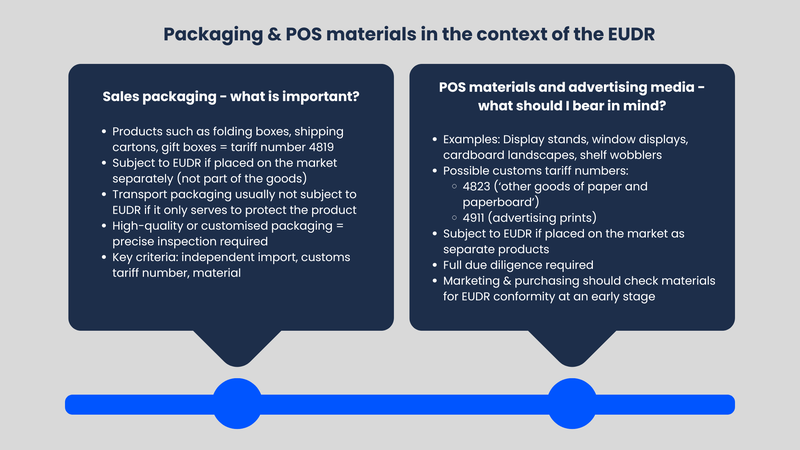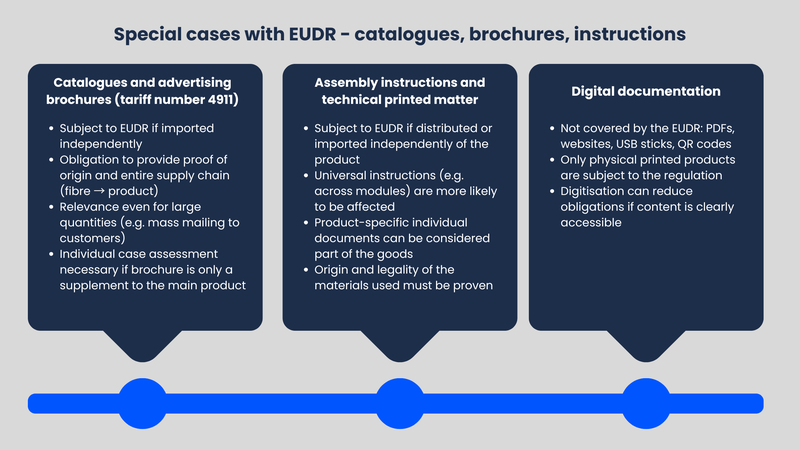EUDR and packaging: When are packaging, displays and instructions covered by the regulation?
EUDR - Reading time: 9 Min

The new EU regulation to combat global deforestation - the European Union Deforestation Regulation (EUDR) - places new obligations on companies. There is currently a lot of uncertainty, particularly in the areas of packaging, displays and instructions for use: Does the regulation also apply to outer packaging? Are paper-based instructions and advertising materials affected? What evidence and due diligence obligations must be complied with? In this article, you will find out when packaging, product instructions, POS displays and other printed products fall under the EU regulation. We will show you how different types of packaging and accompanying materials are classified, where there are exceptions and how you can safely implement the requirements of the EUDR.
The most important facts at a glance
Yes - if they are imported or distributed as independent products, they are covered by the EUDR.
Yes, if they are made of wood or paper and are placed on the market independently.
Yes, if they are traded separately and are not considered personal correspondence.
The entire supply chain - from the origin of the raw material to the finished product - must be traceable and deforestation-free.
No, digital content such as PDFs or online manuals are not covered - only physical printed products are subject to the regulation.
Executive Summary
The new EU regulation to combat global deforestation (EUDR), which will come into force at the end of 2025, presents companies with new challenges - especially when dealing with paper and wood products such as packaging, sales displays, instructions and advertising materials. Whether these materials fall under the EUDR depends on whether they are traded as independent products and which product group they are assigned to according to the customs tariff number. The classification of packaging, POS displays and printed products such as catalogs or instructions for use is often particularly complex. The material composition, the intended use and the type of provision are decisive factors. Even seemingly incidental materials, such as service documents or seasonal advertising materials, can be subject to EUDR if they are imported or distributed separately from the main product. Companies are obliged to fully document the origin of all affected materials - from the raw material to processing and the end product. For legally compliant implementation, companies should check all affected products and product groups at an early stage, analyze their supply chains and establish clear internal processes, such as due diligence declarations and risk assessments. This is the only way to avoid legal risks and at the same time firmly anchor sustainable standards in the company.
EUDR basics: Which products does the regulation apply to?
The EUDR comes into force on December 31, 2025 and is intended to ensure that certain raw materials and products made from them do not lead to deforestation or forest degradation when placed on the market within the EU. It obliges companies to comply with due diligence obligations and carry out risk assessments. It is intended to prove that raw materials and products made from them, such as paper and wood products, have been obtained legally and without deforestation and in compliance with the relevant legal provisions.
What the EUDR regulates - and what it doesn't
The EU Deforestation Regulation applies to a clearly defined list of raw materials and products, which is based on the EU customs tariff numbers. In particular, it covers products made from soy, beef, palm oil, coffee, rubber, cocoa and wood. This also includes numerous paper products made from wood. The product code numbers include various forms of wood, cellulose, veneer, chipboard and a large number of paper and cardboard products. However, not every product made of paper or wood falls under the EUDR across the board. Exceptions apply, for example, to certain consumer goods, medical devices or goods declared as "correspondence". The decisive criterion as to whether a product falls under the EUDR is always the exact product type, the intended use and the customs tariff number. It is worth taking a look at the EUDR annexes and the EU Commission's explanatory FAQs, which are updated regularly.
Packaging as a special case
Packaging is a special case under the EUDR and is often difficult to classify in practice. Whether they actually fall under the regulation essentially depends on how they are placed on the market: Are they traded as stand-alone products, or merely as part of a main product, such as a machine or a consumer good? The new regulation generally applies if packaging is made of wood or paper and is considered a separate product when imported or made available on the EU market for the first time. Certain product codes are particularly relevant here, such as
- 4819: Packaging paper and cardboard (e.g. folding boxes, carrier bags)
- 4821: Paper labels
- and other customs tariff numbers that apply to wood or paper products
Things get particularly tricky with so-called service packaging and POS displays (point-of-sale materials such as stands or advertising displays). Even if at first glance they "only" serve to present or protect a product, they are often produced, procured and placed on the market separately. In such cases, they are legally considered independent products - and can therefore also fall under the EUDR application.
A key point in the assessment is the customs tariff number(TARIC code) and the question of whether the packaging material is imported into the EU or made available separately or together with a product. This differentiation determines whether the packaging is subject to the requirements of the EUDR. This means that even companies that do not sell wood or paper products in the narrower sense, but only use packaging, package inserts or advertising materials, may have to fulfill the due diligence and verification requirements of the EUDR. This includes, among other things, documenting the origin of the raw materials used and proving that they are not associated with deforestation or forest degradation.

Instructions and user manuals - subject to EUDR?
Paper-based product and user instructions accompany almost every technical or electrical device. Many companies are therefore wondering whether these accompanying materials - often regarded as an inconspicuous part of the final packaging - can be covered separately by the EUDR. The correct classification is crucial in order to avoid legal risks due to incorrect classification.
Paper-based instructions are printed products
Many instructions, installation instructions or warranty cards are made of printed paper and are therefore classed as printed products. The EUDR explicitly includes certain paper and printed goods, unless a clearly defined exception applies. According to the current customs tariff, brochures, leaflets and technical manuals, among other things, fall under product group 49, which is covered by the EUDR. This means that if such printed products are imported or circulated separately - for example as individual leaflets, information sheets or advertising material - they are generally subject to EUDR.
This is particularly important for international manufacturers who do not produce instructions for use, warranty cards or technical documents themselves, but purchase them separately or supply them with the product. These components of a product must also comply with the due diligence obligations of the EUDR - particularly with regard to traceability and proof of a deforestation-free supply chain. Important to know: Not only paper alone is affected. Combined printed products, such as film-coated manuals or laminated information material, can also fall under the regulation. The additional material therefore does not automatically protect against the obligation to comply with the EUDR requirements.
Check exception: Is it "correspondence"?
The EUDR contains an important exception for so-called "correspondence". This refers to documents that are personally addressed and exchanged between specific recipients - for example letters, invoices or communications between companies, authorities or consumers. Such items are not considered to be independent products within the meaning of the EUDR and are therefore exempt from the regulation. In practice, however, this exemption only applies in a few cases. Most product instructions, warranty cards or assembly instructions are not addressed personally, but are printed in large quantities for many recipients. They are therefore not considered correspondence and are generally covered by the EUDR.
Nevertheless, details may be important in individual cases. A good example is an individually issued certificate, for example for a machine with a serial number - this can certainly be considered personal correspondence. A general assembly plan or standard operating instructions, on the other hand, are typically not exempt. For companies, this means that they should check exactly which print products are actually created individually and which are not. It is advisable to introduce clear internal categories and review processes for all types of documents and packaging. This is the only way to ensure that the correct EUDR classification is made - and that there are no unpleasant surprises at customs or market surveillance.
Sales packaging, displays and POS materials - how are they classified?
Not only secondary packaging, but also POS (point of sale) materials, sales displays and marketing materials are traded across borders as part of modern goods logistics. The extent to which these fall under the EUDR depends on their material composition, their function and their individual tariff classification.
Sales packaging - what does it include?
We encounter sales packaging every day: from folding boxes for food to shipping cartons and elaborate gift boxes. Customs tariff 4819 explicitly lists packaging made of paper, cardboard and paperboard. This includes typical consumer packaging of all kinds - as long as it is placed on the market, imported or distributed independently, i.e. as a separate item. One sticking point: packaging that is imported together with the actual goods (e.g. as sets or palletized goods) is not always classified as an independent product subject to EUDR. In the recitals, the EUDR explicitly refers to so-called transport packaging, which is only used to protect other goods from damage. According to the current status, these are not always subject to EUDR if they appear as part of the protected goods during import and are not traded separately. This issue becomes more important, for example, for companies that purchase individual high-quality sales packaging for their own brands (e.g. with special printing inks, wood engravings or service lines). In this case, precise assignment to the customs tariff and documentation of the supply chain is essential in order to avoid fines or delivery stops.
POS displays and advertising materials made of paper
POS materials - i.e. all marketing materials at the point of sale, such as stands, window displays, shelf wobblers or cardboard landscapes - are becoming increasingly important in the retail sector. Many are made of printed cardboard, sturdy corrugated cardboard or wood. As these products are often listed under their own goods codes (e.g. as "other articles of paper and paperboard" under tariff number 4823 or as advertising prints under 4911), they may be covered by the EUDR as soon as they are placed on the market independently.
An illustrative example: An internationally active electrical appliance manufacturer has new, large-format advertising displays made of printed cardboard produced in the EU for its market entry and installs them centrally in all stores. The EUDR compliance rules apply to these POS materials, even if the displays are only used temporarily and then disposed of. A full due diligence check of the paper or wood materials used is required. Marketing departments and manufacturers of advertising materials should pay particular attention to whether their temporary displays, give-aways or stands fall under the EUDR. These materials must not only comply with the usual environmental requirements, but may also have to meet the special requirements of the EUDR.

Catalogs, brochures and assembly instructions - Check special cases
Not only packaging, but also many other inserts, information materials and technical accompanying prints are potentially EUDR-relevant. However, there are numerous industry-specific exemption rules that require careful examination.
Catalogs and advertising brochures
Catalogs, leaflets and advertising brochures generally fall under customs tariff number 4911. This product group is explicitly mentioned in the EUDR, which means that the due diligence obligations relating to the origin of the paper used and compliance with sustainable forest management also apply to these printed products. For companies that regularly send out large quantities of advertising materials - such as several thousand catalogs per year to customers in the EU - this means that they must be able to provide complete proof that the paper used comes from legal and deforestation-free sources. The EUDR not only requires information on the type of paper, but also on the entire supply chain - from fiber extraction, processing and finishing to the finished end product.
One example: If a fashion company has its spring catalog produced by an international print shop, it must ensure that all paper types used are documented and EUDR-compliant. It doesn't matter where the printing takes place. However, not every case is the same. It depends on whether the brochure is considered a stand-alone product or is only provided as part of another service. If, for example, it is a supplement to a machine delivery with service information, a case-by-case assessment is necessary. Two questions in particular play a role here:
- How independent is the brochure in relation to the main product?
- What is its economic value compared to the main product?
Depending on the answer, the EUDR obligation may then be confirmed - or not. Companies should therefore precisely document the context in which they use such printed products.
Assembly instructions
Assembly instructions, assembly aids or technical drawings are often produced as independent printed works, particularly in the construction industry, in plant engineering and in the machinery trade. As with other instructions, such printed products fall under EUDR if they are marketed, imported or distributed independently of the main product. However, the following applies here: Assembly instructions that are universally applicable and do not refer directly to an individual product are more likely to be subject to the EUDR compliance obligation than documentation provided specifically for exactly one machine. A typical example: A machine manufacturer imports modules from Asia every year and publishes cross-module assembly collections in several languages as printed work for each delivery. Here, the origin and legal sourcing of the processing materials must be proven - otherwise there is a risk of warnings and delays at customs.
What about digital documentation?
One trend in recent years has been the shift of operating instructions, service brochures and marketing documents to digital form. The question arises: Is digital documentation, for example as a PDF on a website or USB stick, EUDR-relevant? In principle, the EUDR Regulation does not apply to electronic data or digital media itself, but only to physical paper and wood products. This means that QR codes printed on the packaging, for example, which lead to the digital instructions, are not covered by the EUDR, but their printed counterparts are.
The situation is different with physical data carriers such as CDs or USB sticks, as only paper or wooden components need to be checked here. Companies can therefore minimize the number of affected products by digitizing their instructions for use and marketing documents. The only prerequisite for this is that the information is accessible and comprehensible to customers in such a way that no legal disadvantages arise.

Recommendations for companies
The classification and implementation of EUDR obligations is challenging, especially for companies with complex or international supply chains. Careful risk analysis and effective internal processes are essential for manufacturers, importers and retailers.
Which areas are affected?
Companies that import, manufacture, store or market paper packaging, sales displays, catalogs or technical documentation themselves are particularly affected. However, companies that work on behalf of others, for example by assembling or distributing products together with packaging and accompanying materials, must also comply with the requirements of the regulation. In such cases, the products are also considered to be "placed on the market" and may fall under the EUDR. This applies to a wide range of materials: from simple folding boxes and complex advertising displays to technical documentation and seasonal advertising materials. Precisely because the boundaries between packaging, marketing material and product inserts are often blurred, companies should take particular care to check which of their goods actually fall under the EUDR.
A key step is to compare your own product codes with the annex to the regulation. In addition, the suppliers and materials used should also be checked - especially for short-term applications such as temporary displays or promotional packaging. Only with a complete overview of your own product range and supply chain can legal risks be reliably avoided.
Establish internal testing processes
Companies should establish a dedicated testing process that systematically assesses all paper and wood products procured or placed on the market for EUDR-relevant components. To this end, it is advisable to integrate the compliance check into existing quality assurance or auditing routines. The following important factors should be taken into account: the clear classification of goods (customs tariff number and function assignment), complete documentation of the supply chain up to raw material extraction and training of the responsible purchasing and import departments on the new requirements. Only a consistent inspection process minimizes the risk of fines, detention of goods or damage to the company's image.
Expand supplier documentation
Many companies are dependent on information from their suppliers in order to comply with the EUDR obligation. Therefore, buyers should specifically request EUDR-relevant evidence from paper or wood suppliers and update it regularly. This includes supplier declarations, data on the origin of the fibers used and legally compliant chain-of-custody certificates in accordance with the FSC or PEFC standard, provided they meet official EUDR requirements.
In practice, it is advisable to use standardized query forms for all affected packaging, POS materials and instructions. Examples from the consumer goods industry show this: Only with transparent supply chains and clear responsibilities can the risk of non-compliance be reduced to a minimum. Companies that rely on complete EUDR documentation at an early stage gain a strategic advantage in international trade and strengthen their reputation.
Excursus: Chain of custody certificates
Chain-of-custody certificates (CoC) prove the complete traceability of a raw material - such as wood or paper - along the entire supply chain, from its origin to the finished product. They confirm that the material comes from a certified, legal source and has not been mixed with non-certified raw materials during processing and trade. In the context of the EUDR, chain of custody certificates help to fulfill the required duty of proof and due diligence, even if they alone do not automatically guarantee full legal compliance.
Conclusion and outlook
The EUDR Regulation covers numerous paper and wood products - but not everything that consists of these substances automatically falls under the scope of application. The exact classification of goods, the functional context (is the product part of another product, stand-alone or consumable?) and the respective treatment during import or distribution are always decisive. Packaging, POS materials and instructions for use require particular care when it comes to compliance, as uncertainties regularly arise in purchasing practice. A technically sound classification, combined with proactive supplier communication and internal process reliability, helps companies to minimize their risk and position themselves for the future.
The most important recommendation is for companies to carry out a comprehensive inventory of their paper and wood products, including all packaging, sales displays and instructions for use, in the short term. The next step is to document complete evidence of the origin of raw materials and legal forestry. Suppliers should be actively obliged to comply with the EUDR requirements. Where possible, a switch to digital documentation can reduce both costs and compliance efforts - provided that the information obligations towards customers remain fulfilled. By taking an early and structured approach, companies not only ensure legal certainty, but also position themselves as sustainable market players in an increasingly responsible business environment.
FAQ
All packaging made of paper, cardboard, paperboard or wood that is placed on the market or imported as independent goods is affected. This includes sales packaging, shipping cartons and often also promotional packaging. Pure transport packaging is not always subject to EUDR if it is an integral part of another product and not a product in its own right.
POS displays and advertising materials made of paper, cardboard or wood are affected by the EUDR as soon as they are produced, imported or distributed as independent goods. Companies should check the relevant product group and customs tariff number and keep the necessary proof of the supply chain.
Yes, if instructions for use, assembly instructions or other accompanying documents are listed as separate goods, they are affected by the EUDR. Examples include components of a set or separate brochures. If they are non-individual, mass-produced instructions, they are regularly subject to EUDR.
Digital manuals and digital instructions on websites, apps or data carriers are not covered by the EUDR. Only physically existing printed works and paper products are affected by the EU Deforestation Regulation. Companies can therefore partially reduce their impact by changing their media.
Proof must be provided for all stages of the supply chain - from fiber production to the end product. This includes confirmations from suppliers, chain of custody certificates and proof of origin. Regular updating and integration of all evidence into internal compliance processes is recommended to ensure legal security for all packaging and POS materials.
